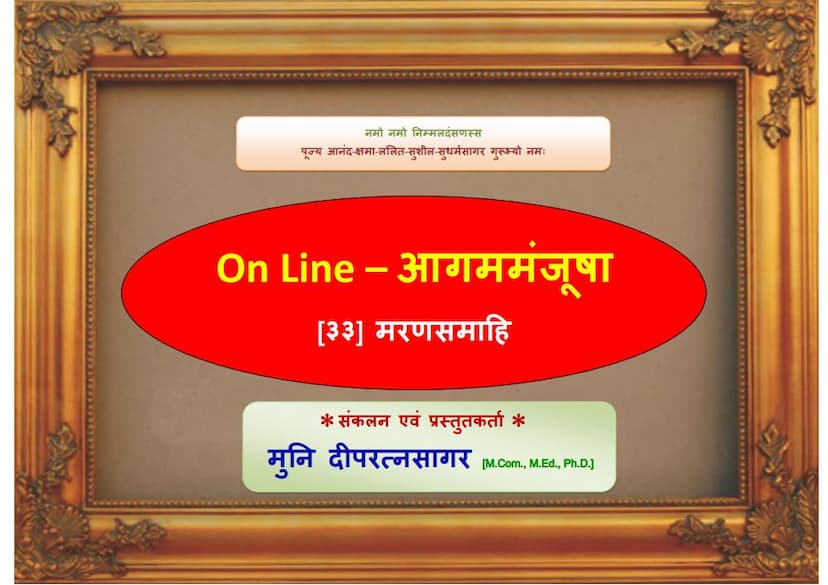Aagam Manjusha 33 Painnagsuttam Mool 10 Maransamaahi
Added to library: September 1, 2025

Summary
This document is a Jain text titled "Aagam Manjusha 33 Painnagsuttam Mool 10 Maransamaahi" compiled by Muni Deepratnasagar, following the path of Acharya Anand Sagar Suri. It focuses on the topic of "Maransamaahi," which translates to "equanimity in death" or "peaceful death."
Here's a breakdown of the key themes and content:
1. Introduction and Purpose:
- The work is presented as an online version of the "Aagam Manjusha," which was originally compiled 70 years prior (in 1942 AD).
- The online version includes some minor variations from the original, such as the inclusion of commentaries (Niyukti, Bhashya) along with the main scriptures, and the inclusion of the "Panchkalpa" and "Pindaniyukti" texts.
- The text is dedicated to spiritual guidance and the attainment of a peaceful end of life.
2. The Nature of a Peaceful Death (Pandita Maran):
- The text extensively discusses the concept of "Pandita Maran" (wise or peaceful death) as taught by the Tirthankaras.
- It contrasts this with "Bala Maran" (ignorant or fearful death), which is characterized by attachment, fear, and a lack of spiritual preparation.
- A significant portion of the text outlines the practices and qualities required to achieve Pandita Maran.
3. Key Principles and Practices for a Peaceful Death:
- Right Faith (Samyaktva): The importance of having unwavering faith in the Tirthankaras, Siddhas, Arihants, Sadhus, scriptures, and the Jain path is emphasized as the first step towards righteous death.
- Right Knowledge (Samyak Gyan): Understanding the nature of the soul, karma, the cycle of birth and death, and the path to liberation is crucial.
- Right Conduct (Samyak Charitra): Adhering to the principles of non-violence (Ahimsa), truthfulness, non-stealing, chastity, and non-possession is vital. This includes practicing the five Mahavratas (great vows) and controlling the senses.
- Penance and Austerity (Tapa): Various forms of penance, both internal and external, are described as essential for purifying the soul and weakening the grip of karma. This includes fasting, controlling diet, and enduring hardships.
- Contemplation and Meditation (Dhyana): The text highlights the significance of meditation and contemplating the true nature of reality, the impermanence of the body, and the eternal nature of the soul.
- Repentance and Confession (Pratikraman/Alochana): The importance of confessing one's sins and mistakes to a guru, expressing remorse, and seeking forgiveness is stressed. This process is seen as purifying and reducing the karmic burden.
- Equanimity: Maintaining equanimity in the face of pleasure and pain, favorable and unfavorable circumstances, and maintaining a detached perspective towards worldly possessions, relationships, and the body is paramount.
- Control of Passions (Kashayas): Overcoming anger, pride, deceit, and greed is repeatedly emphasized as crucial for a peaceful death.
- Renunciation (Vairagya): Detachment from worldly desires, attachments, and the physical body is a core theme.
- Understanding Impermanence: The text repeatedly reminds the reader of the impermanent nature of the body, relationships, wealth, and life itself to foster detachment.
- Endurance of Hardships (Parishaha): The text details numerous examples of great souls who endured extreme hardships and persecutions with equanimity, demonstrating the path to overcoming them.
4. Examples and Narratives:
- The text is rich with stories and examples of monks and ascetics who achieved peaceful death through their rigorous spiritual practices and unwavering faith. These narratives serve as inspiration and practical guidance.
- These examples often involve enduring severe physical suffering, torture, and challenging circumstances with inner strength and equanimity.
5. Specific Practices Mentioned:
- Sallekhana: The practice of gradual renunciation of food and worldly attachments leading to a voluntary and peaceful death.
- Aayambila: A specific type of penance involving specific dietary restrictions.
- Pāvoavagamanam: A practice of self-sacrifice or entering a voluntary death, often through meditation or certain ritualistic means.
- Ingini: A practice of entering a state of deep meditation, leading to the shedding of the body.
6. Ethical and Philosophical Underpinnings:
- The text reinforces the Jain doctrine of Karma, highlighting that one's actions in this life determine the nature of their future births and their death.
- It emphasizes the distinction between the soul (atma) and the body (sharira) and the importance of realizing the soul's true nature.
- The ultimate goal is liberation (Moksha) from the cycle of birth and death.
In essence, "Maransamaahi" is a comprehensive guide that instructs Jain practitioners on how to live a spiritually disciplined life, culminating in a death that is not an end, but a transition to higher realms or liberation, achieved through faith, knowledge, conduct, penance, and equanimity. The text aims to provide a clear understanding of the path to overcome the fear of death and attain spiritual peace.